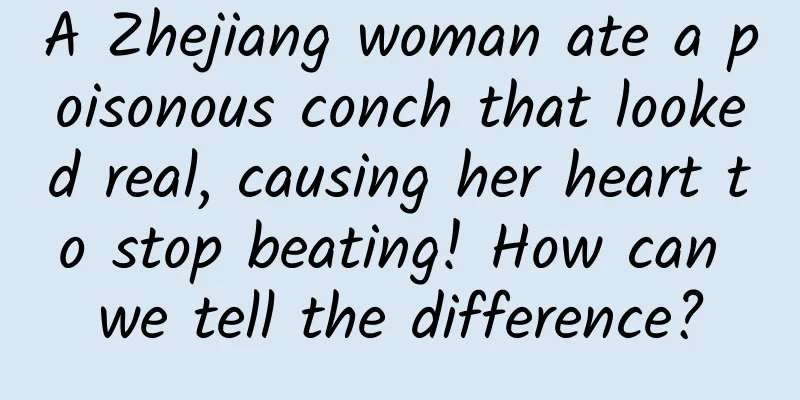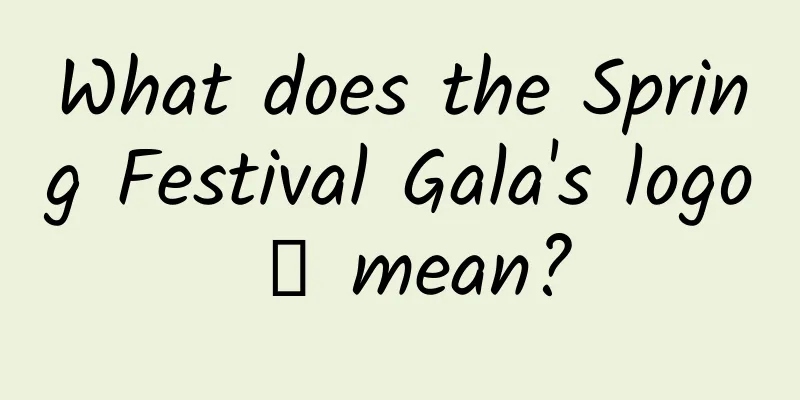A Zhejiang woman ate a poisonous conch that looked real, causing her heart to stop beating! How can we tell the difference?

|
On June 9, Ms. Zhang, a 51-year-old woman engaged in seaside aquaculture in Zhejiang, developed symptoms of poisoning such as nausea and vomiting within an hour after eating conchs she caught herself. She was eventually sent to the emergency department of the hospital. After several hours of rescue in the hospital's ICU, Ms. Zhang's symptoms finally improved. According to the photos provided by Ms. Zhang's family, Ms. Zhang ate "cut snails". She herself claimed that "I had eaten a few before and nothing happened, so I just caught more this time." Thinking back on it, Ms. Zhang was terrified. She was a professional in "mariculture" and could not avoid being fooled this time. If she had eaten a few more, would her life have been over? What kind of species is this poisonous conch that looks real? How can we prevent it from being eaten by mistake when fishing at the seaside? Hidden killer weaver snail Although Ms. Zhang eventually recovered, in fact, the official name of the cut-fragrance snail is "weaving-patterned snail". This kind of snail can be said to have "a bad record". It has been committing crimes in coastal areas for decades and often causes poisoning. The State Food and Drug Administration and local food management departments have also issued numerous warnings against this "weaving-patterned snail". Let’s take a closer look at this weaver snail. The weaving snail, commonly known as the sea snail, sea snail, wheat snail or white snail, is mainly distributed in coastal areas such as Zhejiang, Fujian, and Guangdong. The weaving snail has a pointed and slender tail, which is about 1 cm long and 0.5 cm wide, about the size of a fingernail. The tetrodotoxin contained in the snails can easily cause food poisoning. The former Ministry of Health issued a 2012 announcement (No. 13 of 2012) that clearly required that no food production and operation unit should purchase, process and sell the tetrodototoxin. It is currently the peak season for the sale of edible snails. The recent national food safety risk monitoring found that there are still tetrodototoxins in the market, and the samples were found to contain high levels of tetrodotoxin. Tetrodotoxin poisoning can cause dizziness, vomiting, numbness of lips and fingers, and in severe cases, death. The incubation period is generally 10 minutes to 3 hours. The toxin is heat-stable and cannot be destroyed by boiling, salting, or sun exposure. There is currently no specific antidote. The weaving snail, commonly known as the wheat snail, white snail, and cut snail, is a carnivorous snail mollusk. Mature individuals are between 1 and 2 cm in length, and large ones can reach about 3 cm. The shell of the weaving snail is long oval in shape. Its biggest feature is that there are longitudinal ribs on the shell, with fine lines between these stripes, and 1 to 3 purple, brown, or reddish-yellow spiral ribbons can also be seen on the shell. The textured snail mainly lives on the sandy or muddy seabed of coastal shallows. It is distributed in the southeastern coastal areas of our country, including Shandong, Jiangsu, Zhejiang, Fujian, Guangdong, Guangxi, etc. In the early years, due to its delicious taste and moderate price, residents along the coast of our country often went to catch it for food. The reason why people often go fishing is that not all the weaving snails distributed in my country are poisonous. The weaving snails in the southeast coastal areas can be divided into three categories: Poisonous snails, non-toxic snails, and seasonal snails. For example, the longitudinal-ribbed snail and the gall-shaped snail are non-toxic, and their toxicity has not been detected so far, and there have been no reports of poisoning. However, the common snail, the checkered snail, and the flower snail are sometimes poisonous and sometimes non-toxic depending on the season. The light snail is poisonous, and its toxicity is relatively high. Since there are many species of cone snails, although most of them are non-toxic or slightly toxic, and there are very few highly toxic ones, the growth environments of poisonous and non-toxic ones overlap a lot, making it very difficult for non-professionals to distinguish them. In the early years, coastal residents often caught both poisonous and non-poisonous ones and took them home to eat, which was a matter of luck. As a result, there have been many cases of poisoning from eating poisonous cone snails. As early as 1985, poisoning incidents caused by eating cone snails occurred in Ninghai County, Zhejiang Province. Five people developed symptoms of poisoning such as dizziness, vomiting, and numbness of the lips and fingers after eating the poisonous cone snails. One person died after rescue in the hospital. Since the 1990s, the consumption of snails has been widespread, and poisoning incidents and deaths caused by eating snails have been on the rise in my country. In 2004, a large-scale consumption of snails in Yinchuan, an inland city, resulted in 55 people being poisoned and one person dying. The poisonous toxin of the cone snail is a paralytic shellfish toxin, the main components of which are a variety of toxins such as tetrodotoxin and saxitoxin. Most of the toxins are difficult to destroy even at high temperatures, and the lethal dose for humans is between 0.6 and 0.9 grams. The incubation period of poisoning by the textured snail is short and the onset is rapid. The incubation period of the toxin after ingestion ranges from 5 minutes to 14 hours. Mild poisoning can cause mild symptoms such as gastroenteritis, nausea and vomiting, diarrhea and abdominal pain. However, severe poisoning is not that simple. In severe cases, respiratory paralysis caused by paralysis of the limbs, trunk, chest and abdomen can occur, as well as severe gastrointestinal bleeding, shock and other symptoms. At the same time, even the same species of snails carry different toxins, which are related to their growth environment. As a result, hospitals are unable to develop a specific treatment method. They can only prevent respiratory paralysis through simple gastric lavage and vomiting, while waiting for test reports for symptomatic treatment. During this period, if the poisoned person ingests too much toxin, it will be too late to rescue them. This has also led to a high mortality rate after snail poisoning in China. Because the toxins of the snail are relatively complex and the public is unable to identify them, the Ministry of Health, local governments and researchers at all levels made various regulations regarding the snail at the beginning of this century. For example, government departments at all levels increased the testing and supervision of the snail toxins, and some regions directly adopted temporary measures to completely ban the fishing, sale and consumption of the snail. Total ban At the beginning, local policies and measures were not mandatory, and there were still many cases of poisoning caused by the sale of snails. Finally, in 2012, the State Food Safety Administration could only issue a mandatory order, "Announcement of the Ministry of Health on Organizing the Prevention of Food Poisoning from Snails": No food production and operation unit may purchase, process and sell snails; if consumers find that a food production and operation unit purchases, processes and sells snails, they should report it to the local food safety regulatory department. At this time, the sales of snails have decreased a lot, but many merchants still take risks and secretly purchase snails to make fried snails in sauce and sell them to customers, resulting in frequent snail poisoning incidents. In order to protect public health, the problem can only be solved through more severe punishment. Now the sale of cone snails can no longer be solved by confiscation, but requires sentencing. In 2021, Zheng, the owner of a lobster restaurant in Yuhuan city, Zhejiang province, became greedy when a customer asked him, "Are you selling seafood like snails and puffer fish?" He found a way to buy snails, processed them into dishes, and sold them to acquaintances in the store. After being reported by someone, he was investigated and dealt with by relevant departments. The boss, Zheng, was prosecuted by the Yuhuan City Procuratorate of Zhejiang Province for selling food that did not meet food safety standards and was eventually sentenced to six months' detention. In many places across the country, people who sell cone snails are often prosecuted and sentenced to prison terms ranging from one year to three months of detention. For example, in 2022, Jiangsu police arrested more than 20 criminal suspects who sold illegal cone snails in Sanmen, Ningbo, Xiangshan and other places. At the same time, food supervision departments in various places have also stepped up inspections in the summer when the consumption of edible snails is huge to prevent the appearance of patterned snails on the market. In addition to the market, what needs to be worried about is the situation of catching them by oneself like Ms. Zhang at the beginning. Fishermen at the seaside still believe that the cone snail is "fresh, tender and delicious", and think that since few people around them have been poisoned after eating it, the probability of poisoning themselves is not high, so they secretly catch it and take it home to eat. This idea is gambling with your own life. For individuals, there is no probability of poisoning, only poisoning and no poisoning. In the absence of a specific drug for cone snails, don't gamble with your life. Conclusion Lobster, barbecue, and fried snails with sauce are the three treasures of midnight snacks and are traditional Chinese delicacies. While enjoying these delicacies, you also need to pay attention to the toxicity of the food itself. Remember not to try food that you are not familiar with or that is poisonous. |
<<: Spherical space city? Sunglasses? The life of future astronauts is full of strange things
>>: International Albinism Awareness Day丨Today, let’s learn about the “Moon Child”
Recommend
The most comprehensive sharing of Douyin operations tips: How to do Douyin marketing well?
During this period, Tik Tok has become popular an...
Ideas and practical techniques for optimizing landing pages in the home improvement industry
You invested in two landing pages and the results...
Product operation, how to build an operation system?
[Introduction] DAU, GMV, CPM, CPC... This series ...
Why is it so cold this year? When will the market pick up in 2022? Attached the latest news
In recent times, cold air has been moving south v...
Why did Sony mobile phones fail in China?
Yesterday, the news of Sony Mobile's massive ...
The World Cup is coming, here are all the tips for brand marketing!
The World Cup is a dream stage for corporate bran...
After iOS 13 was released, I compiled this update of Apple's Human Machine Design Guidelines
After Apple announced iOS 13 at WWDC (Worldwide D...
From 0 to 1 entry-level e-commerce store operation plan
Many friends who do e-commerce often come to cons...
Authoritative answers! 7 practical questions about antigens: Can we only do nasal swabs? What should we do if the test is positive...
Yesterday, the Comprehensive Group of the Joint P...
Tips for creating a private circle of friends!
In the one month since I started doing private do...
ViewController has many good transition animations
Source code introduction Cool transition animatio...
4 cases of Super Fans Pass, let the data speak for themselves!
We have previously introduced the new features of...
Dell's all-in acquisition of EMC causes 10 shocks
[[151859]] Text/Lao Liang on the front line Hopef...
Snake venom is both a deadly poison and a life-saving medicine | Talking about snakes in the Year of the Snake
This year is the Year of the Snake in the Chinese...
How can major manufacturers prove their innocence when Android fingerprint unlocking is hacked?
Just look at your own phone to see how unsafe thi...









